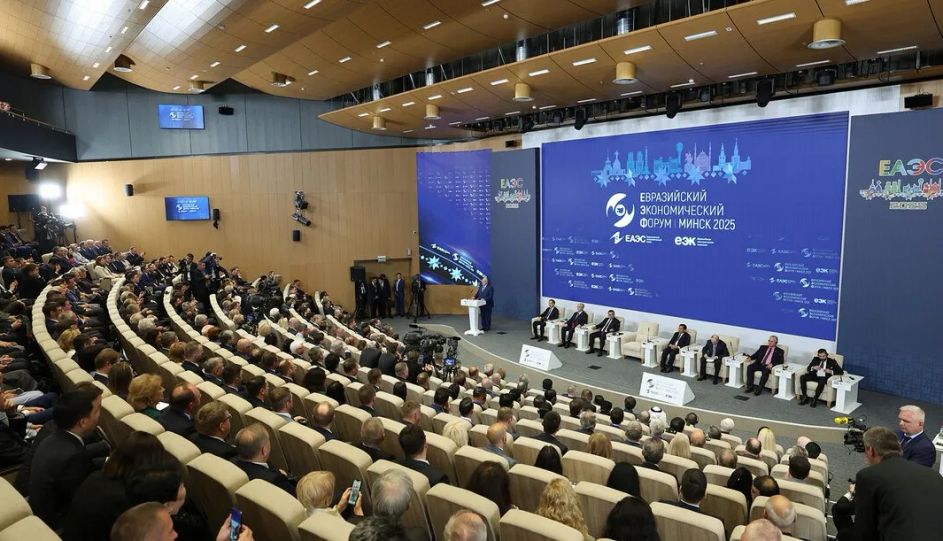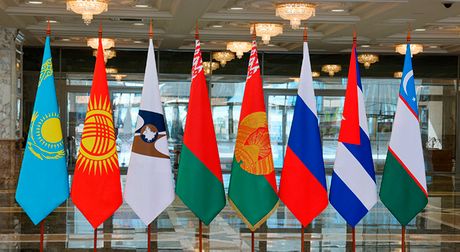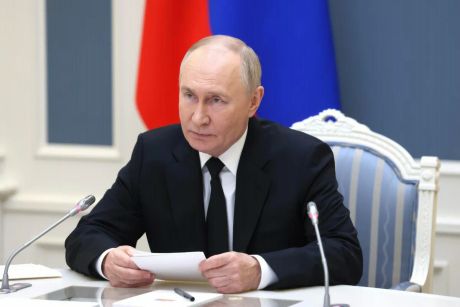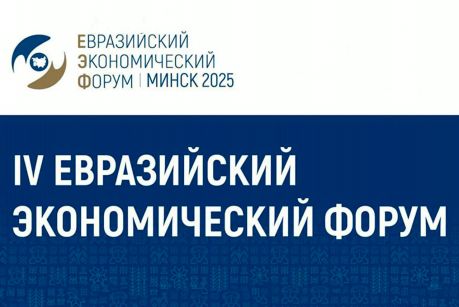Lukashenko took part in the 4th Eurasian Economic Forum at the Minsk International Exhibition Center
08:55, 27 June

Photo: the press-service of the head of the Belarusian state
Belarus President Aleksandr Lukashenko took part in the 4th Eurasian Economic Forum at the Minsk International Exhibition Center on 26 June. It was timed to a session of the Supreme Eurasian Economic Council. Both events have been organized within the framework of Belarus’ presidency in bodies of the Eurasian Economic Union in 2025, press-service of the head of the Belarusian state has learned.
- Поделиться в Facebook
- Поделиться ВКонтакте
- Поделиться в Twitter
The forum’s program included six major thematic blocks comprising 35 events, with more than 2,700 participants from 33 countries expected to attend.
The head of state and other heads of state took part in the plenary session “The strategy of Eurasian economic integration: Results and prospects”.
This year Belarus is presiding in the EAEU bodies, Aleksandr Lukashenko stressed. The Eurasian Economic Forum is the union’s largest open discussion platform.
“There are representatives of more than 30 countries here today. I am sure that the exchange of views held during the day and the one that will still follow will be useful for the further development of the EAEU,” the President said.
The EAEU has already marked its 10th anniversary. Contrary to skeptics, the association showed the ability to find mutually acceptable solutions and working compromises, the head of state said. “It is not only functioning, but is also making success in all basic parameters,” Aleksandr Lukashenko said.
The President cited several indicators. Over 10 years, the mutual trade in the EAEU has more than doubled and foreign trade has increased by 37%. The total GDP of the Union grew by almost 18%, industrial production by 30%, agricultural output by 25%, freight turnover by 10%, investment by more than 40%. The unemployment rate has almost halved to 2.8%.
“Eurasian business has fully experienced the advantages of duty-free cross-border trade and the application of uniform rules of law and unimpeded settlements in national currencies. An important achievement for our citizens is the possibility of free employment in the EAEU. The Union has launched the digital service “Work Without Borders”, ensured equal rights in pension provision, recognition of educational documents,” the Belarusian leader said.
The Eurasian Economic Union has observer countries on different continents. The EAEU concludes trade agreements. “This means that both the EAEU international footprint and functionality are expanding,” the head of state added.
The head of state noted that the EAEU is expanding both in terms of geography and scope. Nowadays, together with its partners, the EAEU represents a fifth of the world’s population and is the largest union by territory.
“This vast territory contains a quarter of all known mineral resources. Our union ranks first in the world in oil production, second in gas extraction and mineral fertilizer production, third in wheat, potato, and livestock output and also in railway length, and fourth in coal mining, cast iron and steel production, meat output, and total length of roadways,” Aleksandr Lukashenko remarked.
However, there is still room for improvement, the President believes. Despite all this, the GDP of the EAEU accounts for only about 4% of the global total.
“What does this tell us? The potential of our integration alliance is not being fully harnessed. Over the next 10 years, we must at least double this figure by giving a new impetus to integration,” the Belarusian leader emphasized.
He stressed that some of the EAEU’s key performance goals have not been achieved. Addressing these challenges largely depends on the Eurasian Economic Commission and the heads of state.
“Each of my colleagues here has the vision for their countries in the medium and long term. We must identify and consistently implement joint measures so that integration brings added value. It should be clear to people that, on our own, without the union, we would not have been able to achieve this so quickly or effectively,” the President stated.
Aleksandr Lukashenko said: “Work on manufacturing cooperation projects has begun. The relevant decisions have been made. The union budget has appropriated considerable funds for these purposes. Instead of catching up with each other in conventional economy branches we should work together to become leaders in new ones, in the economy branches we may not even think about. By combining the potentials of our economies, we will be able to create a unique Eurasian product. From aircraft and trains to digital solutions and artificial intelligence.”
“When the Treaty on the Eurasian Economic Union was signed, the year 2025 was defined as a kind of horizon, beyond which a new stage in the history of association would begin. And today we can present individual elements of the EAEU 2.0. Amid global turbulence, it is important to be proactive when dealing with situations, to influence the global agenda in a positive way, to have effective patterns for responding to external challenges,” Aleksandr Lukashenko emphasized.
According to the President, in order not to get lost in the oversaturated global market, the EAEU 2.0 must have its own signature product that should be noticeable, popular and truly common to all the member countries. “This is a basic condition for taking and maintaining positions on the world stage,” the Belarusian leader noted.
At the beginning of the year, after assuming chairmanship in the organization, Belarus urged the member states to collaborate in areas crucial for staying competitive on the global market. These are electric transport, microelectronics, robotics, information and communication technologies, and new materials.
“Work on joint projects has begun, decisions have been made, and considerable funds have been allocated for these purposes from the EAEU budget. We must not compete with each other in traditional industries, but together take the lead in new industries, the ones that we have not probably considered yet. There is no escaping it. By combining the potentials of our economies, we are able to create a unique Eurasian product - from airplanes and trains to digital solutions and artificial intelligence. We have already learned to do some things in these areas,” said Aleksandr Lukashenko.
In the EAEU 2.0, it is necessary not only to combine potentials, but also to rationally distribute efforts and resources. “It is obvious that every country needs [access to] space, but not every country has a cosmodrome. The same can be said about other industries in the EAEU,” the Belarusian leader noted.
According to him, instead of competing and creating overlapping capacities, it is necessary to focus on converging national economies, integrating existing flagships into production chains in order to create a common product offering for the EAEU market and third countries.
A breakthrough also requires combining scientific, engineering and financial potential. Aleksandr Lukashenko is sure that creation of joint research and innovation centers to develop new technologies and products is a great idea.
“By integrating science and manufacturing, with a focus on exports, we can achieve both technological independence and a strong competitive position in the global market,” the President emphasized.
Aleksandr Lukashenko went on saying that the services sector generates half of the total GDP of the EAEU. “There is significant potential for further expansion and development within this sector. Joint efforts to establish modern transport corridors across national segments, ultimately integrating a broader Greater Eurasia, can produce immediate economic returns,” the Belarusian leader said.
According to the Belarusian head of state, a belt of good neighborliness has been created in the south and east of the EAEU. Aleksandr Lukashenko proposed to connect it with a network of roads, railways, transport and logistics hubs.
“Integrated Eurasian transport and logistics corridors should become smart, multimodal, eco-friendly arteries with a single digital administration platform,” the President said. “Reducing the time and cost of transit through Eurasia will increase the competitiveness of the route compared to the sea routes. It will help position the EAEU as a global transit hub.”
Aleksnadr Lukashenko suggested studying this initiative together with observer countries and within the framework of the EAEU-SCO interaction.
Aleksandr Lukashenko believes that financial integration, particularly within the services sector, acts as another catalyst for economic growth. “In the EAEU 2.0, investments must cross borders, creating new opportunities. It is necessary to complete the formation of a common financial market as soon as possible: sign and ratify agreements on a standardized license in the banking and insurance sectors, as well as agreements on mutual admission of financial market participants,” he said.
According to the President, the focus on digitalization is inevitable in the EAEU 2.0. “The creation of a single digital platform for business, the development of e-commerce, the use of big data - these are the areas that will make our economies more efficient,” the President said.
“We need to drop slogans calling to preserve the national digital sovereignty inside the union. On the contrary, it is necessary to converge the software platforms we use and enable the transboundary exchange of information from national databases and registries, recognize digital signatures and digital documents,” the Belarusian leader emphasized.






